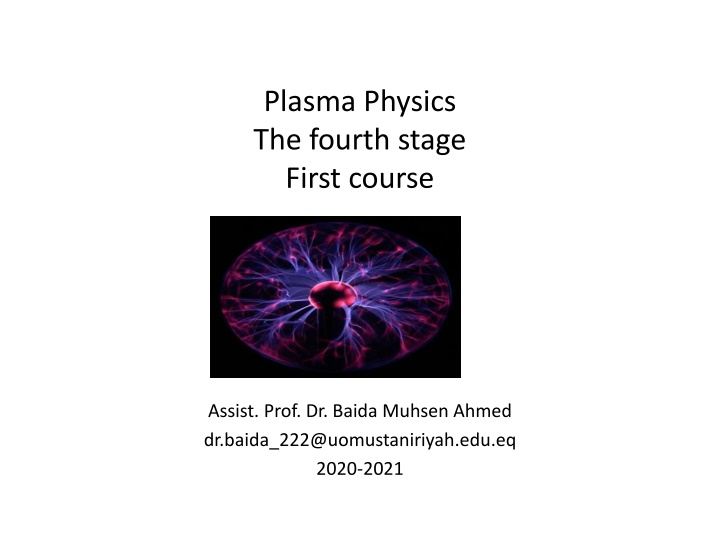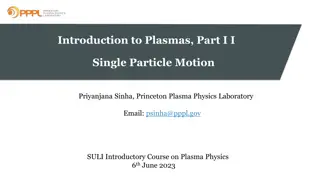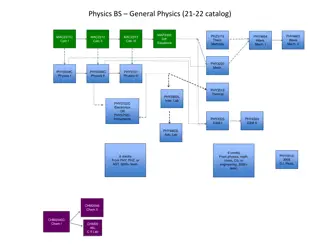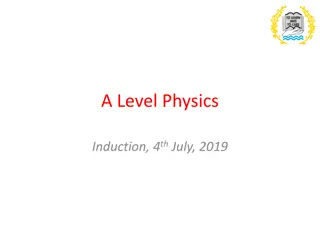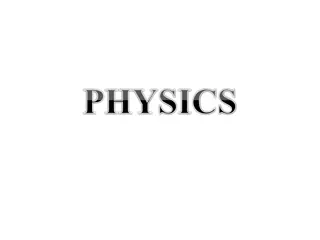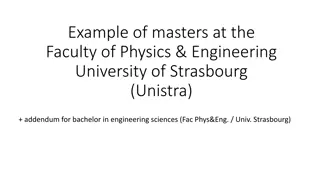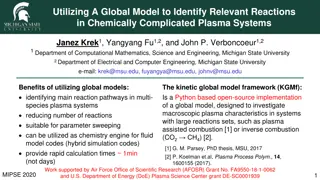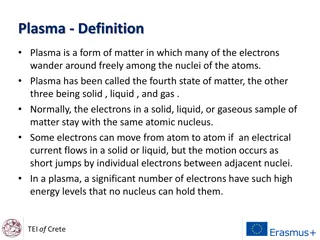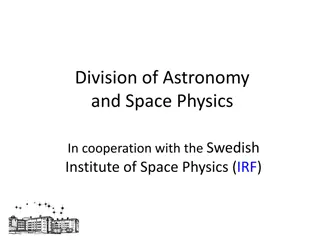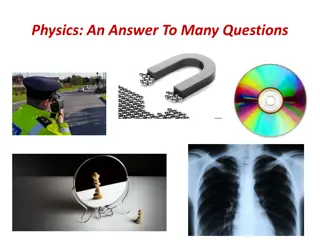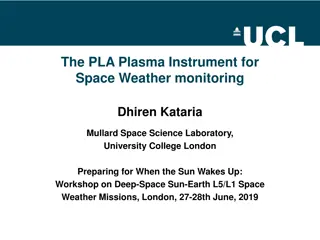Plasma Physics: The Fourth Stage First Course by Prof. Dr. Baida Muhsen Ahmed
Plasma, the fourth state of matter, was introduced by Langmuir in 1928. It is a unique form of matter containing ions and exhibits collective behavior. This course explores the relationship between solid, liquid, gas, and plasma, discussing forces, parameters, and where plasmas are found in the cosmos and on Earth.
Download Presentation

Please find below an Image/Link to download the presentation.
The content on the website is provided AS IS for your information and personal use only. It may not be sold, licensed, or shared on other websites without obtaining consent from the author.If you encounter any issues during the download, it is possible that the publisher has removed the file from their server.
You are allowed to download the files provided on this website for personal or commercial use, subject to the condition that they are used lawfully. All files are the property of their respective owners.
The content on the website is provided AS IS for your information and personal use only. It may not be sold, licensed, or shared on other websites without obtaining consent from the author.
E N D
Presentation Transcript
Plasma Physics The fourth stage First course Assist. Prof. Dr. Baida Muhsen Ahmed dr.baida_222@uomustaniriyah.edu.eq 2020-2021
WHAT IS A PLASMA Langmuir in 1928 is the first one introduced the word plasma . Ionization degree described the state of the plasma.
Its a singular form of matter which contains ions most of the matter around us consists of neutral atoms and equal number of electrons and protons, so their charge is balanced on Plasma. Detailed explanation of the relationship between solid, liquid and gas arrive to plasma. First and foremost, a plasma is an ionized gas. When a solid is heated sufficiently that the thermal motion of the atoms break the crystal lattice structure , usually a liquid is formed. When a liquid is heated enough that atoms vaporize of the surface faster, a gas is formed. When a gas is heated enough that the atoms collide with each other and knock their electrons in the process, a plasma is formed: the so-called `fourth state of matter'.
Atmospheric Pressure Plasma Jet and Dielectric Barrier Discharge (DBD) in Nitrogen
Forces in the plasma In most materials the dynamics of motion are determined by forces between near-neighbor regions of the material. In a plasma, charge separation between ions and electrons gives rise to electric fields, and charged-particle flows give rise to currents and magnetic fields. Plasma:- is a quasi-neutral contain charged and neutral particles that exhibits a (collective behavior). Quasi-neutrality: number densities of electrons, ne, and ions, ni , with charge state Z are locally balanced: ??= ??? Collective behavior: The motion that dependents not only local conditions but on the state of the plasma in remote region
Three fundamental parameters characterize plasma: 1. The particle density n (measured in particles per cubic meter), 2. The temperature T of each species (usually measured in eV, where 1 eV=11 605 K), 3. The steady-state magnetic field B (measured in Tesla)
Where are plasmas found? 1- cosmos (99% of visible universe): interstellar medium (ISM) stars 2- Earth: fusion devices street lighting plasma torches discharges - lightning Plasma accelerators! The upper atmosphere (the ionosphere) Stars and the Sun How can we produce plasma heating ionized it by (a) driving E (b)shining radio waves
Thermal plasma exist in, Low-energy plasma: This weakly ionized plasma can exist only at very low pressure in closed containers Examples include fluorescent lamps, neon signs, plasma globes, plasma TVs They easily form at room temperature, so they cool enough to touch. Medium-energy plasma: Partially ionized plasma is much hotter, so it can exist even at normal air pressure Examples include fireworks, the surface of the Sun, metal cutting plasma torches Their temperature is around ten thousand degrees. High-energy plasma: Super-mega hot (many millions of degrees) and fully ionized Very hard to create here on Earth, but it exists at the Sun s core Earthly examples include exploding bridge wires, particle accelerators, and nuclear explosions At these pressures and temperatures, hydrogen nuclei can fuse, releasing a lot of energy plasma.
